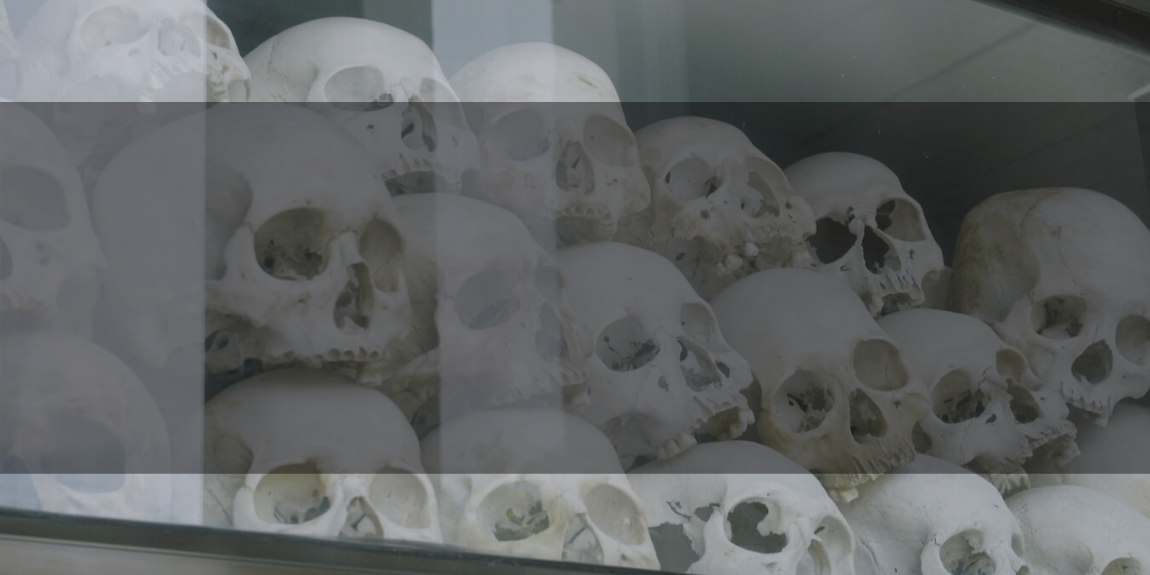On the last day in Cambodia, we felt it was necessary to take a few hours out of our day to learn about the dreadful events that affected the Cambodian people under the Khmer Rouge regime. For $15, a tuk-tuk took us 17km out from Phnom Penh to one of the most infamous spots in Cambodia, the killing fields and genocidal centre at Choeung Ek.
From the parking lot, the space seems like a serene park, with a large memorial in the centre. Birds sang and butterflies batted their wings through the trees on the grounds as you walked through the gates. The entry fee is $4USD, which includes an audio tour in your choice of language. Each stop is indicated by a number which, when pressed into the hand-held device, gives a brief history of the spot and its significance.
At the beginning of the tour, the narrator fills you in on the Democratic Kampuchea, their grizzly start, and how in four short years, 1.7 million Cambodians died under their power. People were herded into the streets and sorted. Intellectuals were killed instantly, being sent to one of over 300 killing fields like this one. City-folk were sent to work 12 hour days doing hard labour on little more than a cup of rice soup a day. They built dams and farmed until they died.
We visited one of these dams during our time in Kampot a few weeks prior. Secret Lake was one of the many projects that forced people out of the cities and into horrible working conditions. A Buddhist temple now overlooks this lake which so many people died digging. Across the water, you can see European expats growing mangoes on the banks.
Back to the tour: There are 19 stops along the journey, each more heart-wrenching than the last. I won’t get into all of them, but I’ll recount a few of the spots that moved me the most. I didn’t take any pictures. For me, this was a learning experience and not part of a vacation. (I even debated writing this, but I thought you guys would be interested.)
One of many mass graves
As you walk through the park, up pops a wooden boardwalk that seems slightly out of place… until you learn why. Next to this boardwalk, the earth is pocked with pits, some no more than a few feet deep. These were mass graves that once went down more than 15 feet, filled with bodies. When the land was liberated, the earth seemed to fester with sores as that were these mass graves. The largest held 450 victims. Bracelets and cash donations are thrown into the burial pits all over the grounds as offerings from the community for those who perished here. Although most of these graves have since been unearthed, there are some who remain conserved beyond the boundaries of the park. Walking on the boardwalk, you learn that tattered clothing and bone fragments seep up from the ground when it rains. These walkways were established to limit the contact with these pieces of horrifying history. Coming off the last step, I nearly stepped on a few strips of cloth coming up from a tree root.
Survivors’ Stories
Just behind the memorial building lies a man-made lake, which more Cambodians died digging. There is a small trail that leads to a beautiful gazebo overlooking this small body of water, which gives you a place to reflect and take in all that happened here. The survivors’ stories were recorded and presented to the tribunal against Khmer Rouge higher-ups in their Crimes Against Humanity hearings. They include accounts of rape, murder, and one man’s story about the entire ordeal, from when he was a teenager forced out of his home, to now, a well-off dignitary who owns a documentation centre.
The Killing Tree
This tree was where the Khmer Rouge beat children and babies to death and standing next to it was as disturbing as you may think. When liberation came, they found women and children buried next to the tree, which still had hair, bone, and brain matter smashed into it. The narrator goes on and on about how these women and children were treated. There wasn’t a dry eye on anyone who was listening. Near the end of the audio clip, you hear the confession and emotional testimony from the former Prison Director, Duch, as he recalls the events that happened right here at this tree. The most offerings were seen in this spot; respectfully adorned with bracelets, ribbons, flowers, and trinkets from those who mourned the terrible loss felt here.
Memorial Stupa
The memorial you see when you walk into the park isn’t just an ornamental building; it houses some of the bones of those that perished here. On the audio tour, you hear about how scientists carefully catalogued each piece, marked them male or female, and arranged them to create a morbidly stunning centerpiece. As you walk up to the monument, you are offered a chance to buy flowers and incense as offerings and instructed to take off your shoes as a sign of respect. We did all three. You enter the cramped building and are immediately greeted by 8,000 skulls staring back at you. Each had been marked where the killing blow had hit. Not like they needed to… almost each one had a visible gash or whole piece missing. Hoes, garden tools, knives, even pieces of palm trees were used to administer the final blows to these poor souls, as the rest of the camp listened to patriotic music to drown out their screams.
There were no smiles as we left the park that day…
Driven by a passion for travel and all things marketing. Fuelled by tea and sarcasm, she’s a gypsy at heart with a knack for telling stories.

